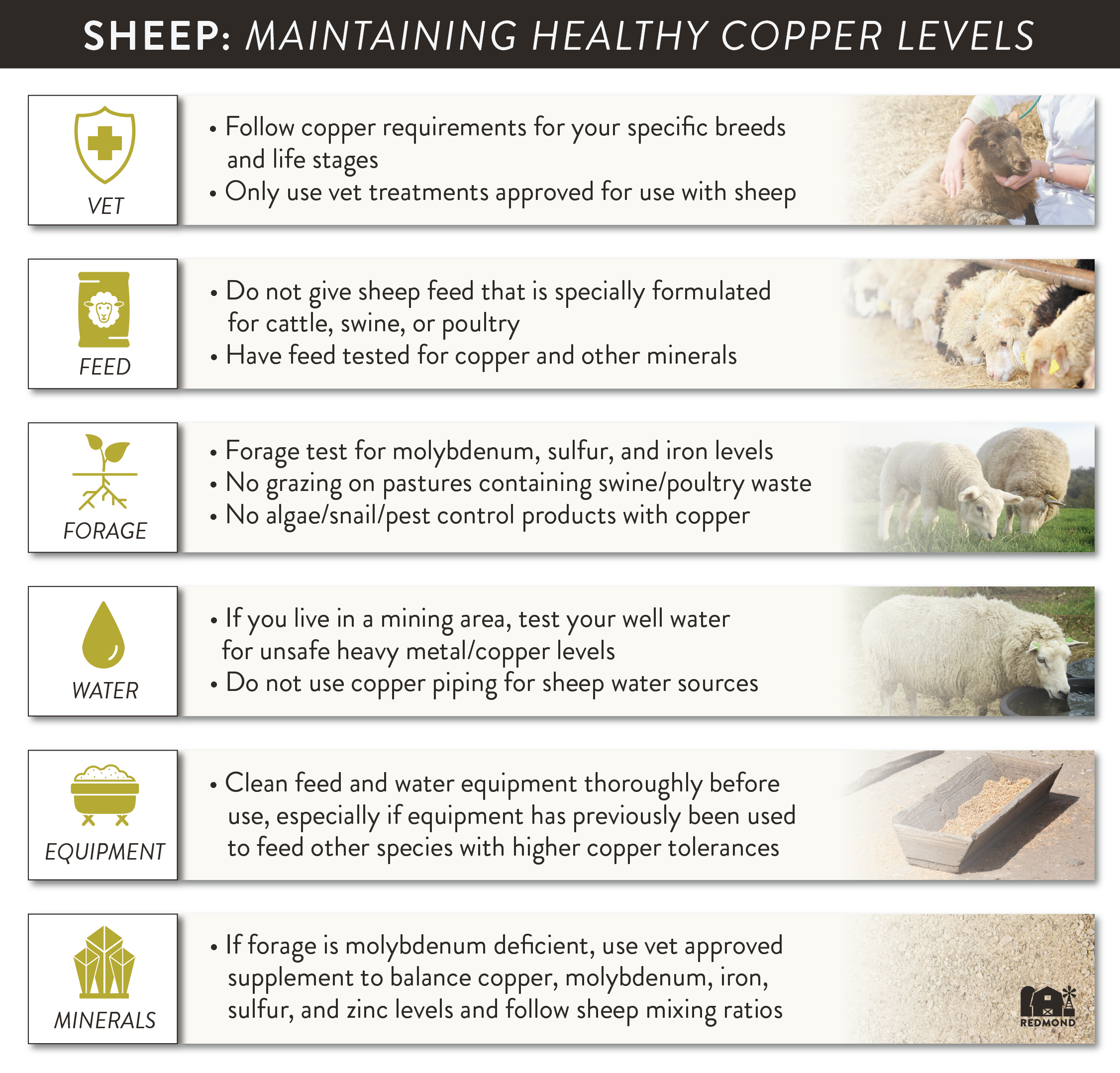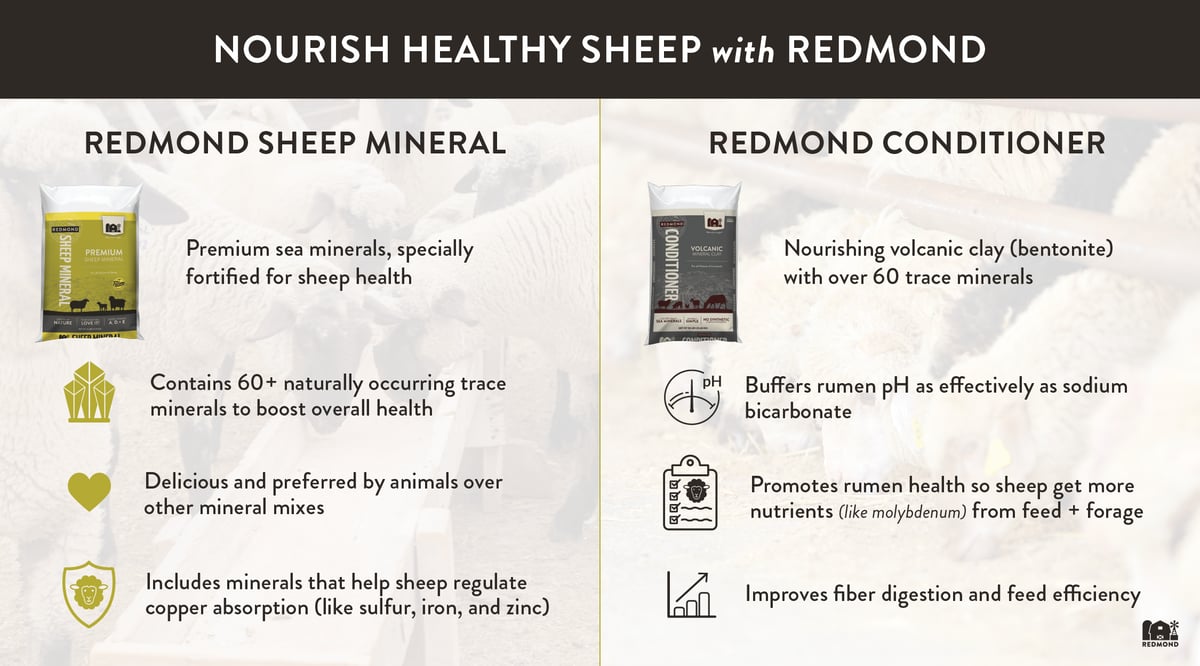The Lowdown on Copper
Copper is on the list of “heavy metals” that are essential for certain biological functions. Dietary copper for sheep supports:
- Bone formation
- Wool growth
- Pigmentation
- Healthy nerve function
- Red blood cell formation
- Immune response, and more
How Much Copper Is Safe For Sheep?
Some farmers have become so scared of copper, that they avoid it all together and their flock health suffers. Sheep absolutely need copper to survive, just not as much as other animals. Sheep have a thin threshold between copper deficiency and toxicosis because their bodies process copper differently than most other species. Most animals absorb copper in their small intestines. Sheep absorb copper in both their small and large intestines plus store excess copper in the liver. From there, their kidneys gradually eliminate excess copper as waste. However, if their liver hits its storage capacity and cannot hold any more, it will release large amounts of copper into the blood.
According to Purdue University, sheep need around 5 parts per million (ppm) of dietary copper to avoid deficiency, but should typically receive 8-11 ppm daily. It is important to note that copper needs can vary depending upon the breed and life stage of your sheep. Consult your veterinarian to ensure you are meeting the specific requirements of your flock.

The Importance of Mineral Balance
Sheep need certain minerals to interact with copper to control how much they absorb and excrete. Molybdenum is the most common mineral used by sheep to prevent copper toxicosis. Plants intake molybdenum from the soil, which are then ingested by foraging sheep.
Molybdenum levels must also be monitored because intaking too much can result in a copper deficiency. Copper to molybdenum ratios should be around 6 to 1 respectively. The Ontario Veterinary College also advises that sulphur, zinc, and iron can also interact with copper to help keep levels where they belong.
Signs of Copper Toxicosis
Once symptoms of copper toxicosis appear, it is very difficult for a sheep to recover. Contact your veterinarian immediately if you notice symptoms or suspect health deterioration in your flock.
According to Louisiana State University (LSU) Ag Extension, copper toxicosis displays the following symptoms:
- Fever
- Dark red or brown urine
- Diarrhea
- Weakness
- Jaundice
- Difficulty breathing
The OVC advises that some neurological symptoms (from hepatic encephalopathy) can act as warnings for chronic liver damage as well.
These symptoms include:
- Appearance of blindness
- Staggering
- Head pressing
- Dull responses
Because copper toxicosis is difficult to reverse, prevention is always the best practice. Let’s take a look at how to maintain healthy copper levels.
How To Maintain Healthy Copper Levels
Here are some best practices for helping your sheep maintain healthy copper levels.

Veterinarian Services
- Consult your vet to ensure you know the specific copper requirements for the breeds and life stages of your flock
- Only use vet treatments approved for use with sheep (ie. some de-wormers contain copper)
Feed
- Only use sheep approved feed rations and closely follow packaging guidelines
- Do not give sheep feed that is specially formulated for cattle, swine, or poultry
- Have your feed tested to learn copper and copper inhibitor levels (molybdenum, sulfur, iron, zinc)
Forage
- Have your forage tested to learn your molybdenum, sulfur, and iron levels
- Do not let sheep graze on pastures containing swine or poultry waste
- Check ingredients on algae/snail/pest control products for copper before use
Water Sources
- If you live in a mining area, test your well water for unsafe heavy metal/copper levels
- Do not use copper piping for sheep water sources
Equipment
- Clean feed and water equipment thoroughly before use, especially if equipment has previously been used to feed other species with higher copper tolerances
Mineral Supplements
- If forage tests show deficient molybdenum levels, use a vet approved supplement
- Under guidance of vet, offer mineral supplements to balance copper, molybdenum, iron, sulfur, and zinc levels
- Be sure to use mixing ratios approved for sheep (follow packaging instructions)
Redmond Mineral Conditioner
Founded by farmers over 50 years ago, Redmond Minerals is lucky to share the health benefits from our rich, ancient mineral deposit. Our mineral program is used by farmers across the country, to raise happy and healthy animals. We are always looking for new ways for animals to enjoy our minerals...introducing, Redmond Sheep Mineral! Our specially fortified mineral mix is tailored to the exact needs of your sheep.

Pair Sheep Mineral with Redmond Conditioner and help your flock get the most out of your mineral program. In ruminant, like sheep, our conditioner buffers rumen and increases how many nutrients your animals are absorbing from their forage and feed. With 0.5 - 1 ounce per head daily ration, your sheep can better absorb molybdenum while also providing them with zinc, sulfur and iron to interact with their copper intake.
A Word About Feed Ratios
When you look at the ppm listed on the bag, don't be alarmed when you see a number higher than the recommended copper intake. Remember that when you add the mineral supplement to your animals' feed, you are adding to a larger food intake, just like diluting a substance in water. Just follow the ration suggestions for sheep and their health will improve accordingly.
Animals crave our minerals, so introducing this supplement will be an easy and beneficial choice you can make for your animals. Give us a call at  to try our supplements; both you and your animals will love it!
to try our supplements; both you and your animals will love it!
© 2024 Redmond Minerals Inc.

